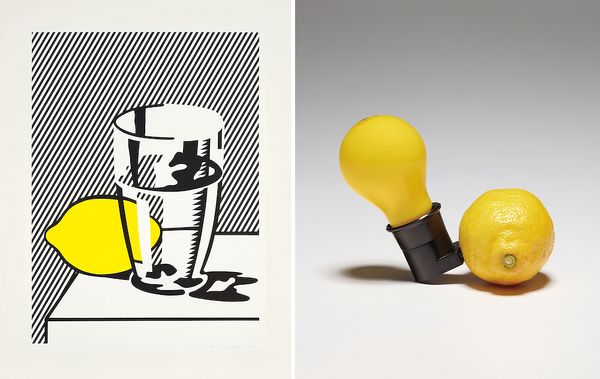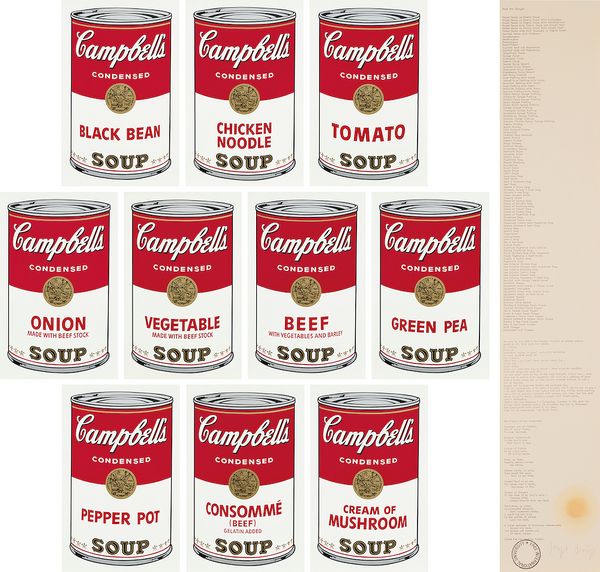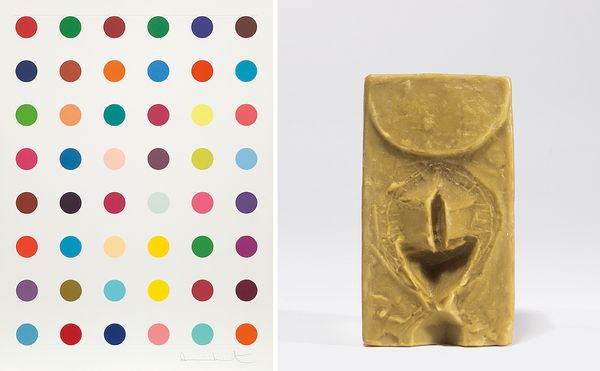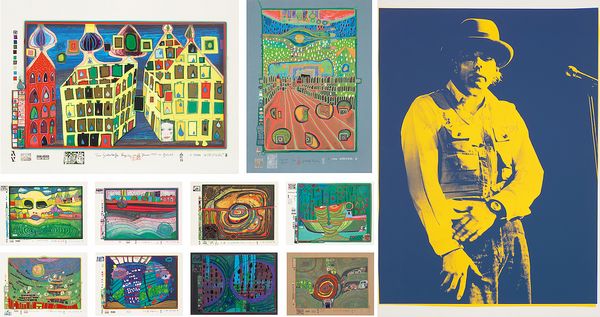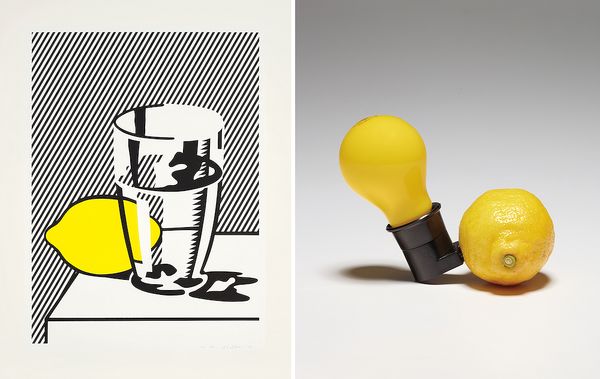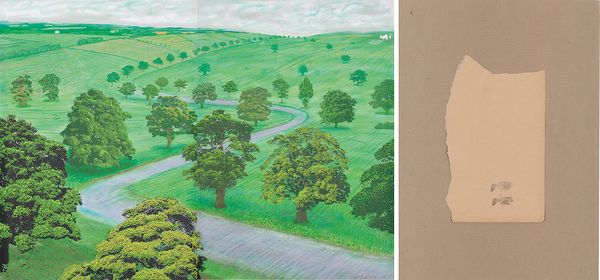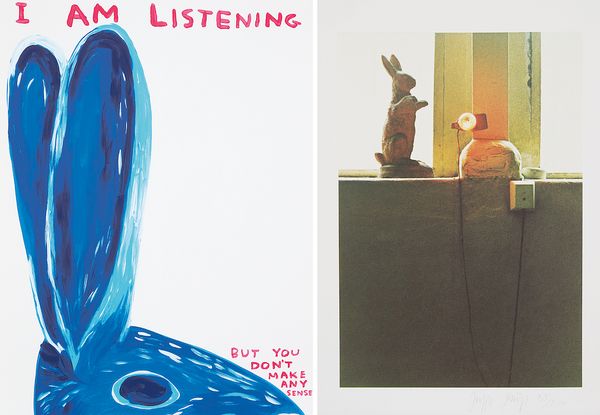Roy Lichtenstein, Untitled (Still Life with Lemon and Glass), from For Meyer Schapiro (C. 134), 1974. Estimate £12,000 - 18,000. Evening & Day Editions London; Joseph Beuys, Capri-Batterie (Capri Battery) (S. 546), 1985. Estimate £10,000 - 15,000. Beuys 100 London.
Robert Kennan, Head of Editions
Andy Warhol, Campbell's Soup I (F. & S. 44-53), 1968. Estimate £600,000 - 900,00. Evening & Day Editions London; Joseph Beuys, Food for Thought (S. 206), 1977. Estimate £1,000 - 1,500. Beuys 100 London.
Waiter! Waiter! There’s a hare in my soup!
In 1968 Warhol made his iconic set of screenprints depicting Campbell's soup cans. Mimicking the ubiquitous, everyday objects around him, he held a mirror up to an American consumerist society in full swing. Nine years later, the world was a very different place; the American dream wasn’t so shiny and environmentalism was emerging. At documenta 6 in Kassel, Germany, Joseph Beuys manned his "Honey pump at the Workplace" installation. To help fund this extraordinary work he produced an unlimited multiple, "Food for thought"; part shopping list, part telephone conversation and part ancient Celtic verse. Beuys wanted to turn the world green, pea green, green pea?! In pursuit of this he found a surprising supporter in Warhol, who designed a poster for Beuys' fledging Green Party in 1978. When the two met for the first time in Germany Warhol proclaimed “‘I like the politics of Beuys. He should come to the US and be politically active there...He should be President." Could there be two more different artists? Both were masters of their respective self-image, carefully constructing their own unique personas. Beuys famously stated "if you have all my multiples, then you have all of me." I think the same could be said of Warhol. As for their shared love of soup, Warhol was certainly a can man; Beuys, never off the shelf, always homemade.
Rebecca Tooby-Desmond, Head of Sale
Damien Hirst, Oleoylsarcosine, 2008. Estimate £10,000 - 15,000. Evening & Day Editions London; Joseph Beuys, Cuprum 0.3% unguentum metallicum praeparatum (S. 556), 1978-86. Estimate £15,000 - 20,000. Beuys 100 London.
One resonates the cool, calm, and reassuringly sterile science of Big-Pharma, the other glories in the crude alchemy of homeopathy. Both demonstrate a fascination, even obsession with healing and spiritual redemption.
Simultaneously compelling and repelling, Joseph Beuys’ Cuprum 0.3% unguentum metallicum praeparatum provokes the uncomfortable squirm of abhorrent words: ointment, poultice, unguent, dare I say, moist? Yet its appeal lies in its defiance of the aesthetic. This work is not here to please you, it’s here to heal you. Let the impression of a miner’s head-torch light a path out of darkness. Let the copper-infused beeswax provide heat and antiseptic for your wounds. Let Beuys’ homemade homeopathy cure you of your ails and restore your spirit anew.
Oleoylsarcosine does please you. Damien Hirst’s immaculate coloured circles are smarties lined up with a ruler, shiny beads collected by an obsessive toddler, a week of pills laid out to be deftly swallowed. “There is nothing to worry about here,” assures the nurse in their crisp gown and powdered gloves. Born of fatty acids, N-oleoylsarcosine is obtained as an oil and used as an emulsifier. A clear, yellow-brown viscuous liquid, Hirst’s pristine polka dots are not so far removed from the organic rawness of Beuys’ materials. Salve, lotion, balm: far more palatable to say, but medicine all the same.
Adam Rutledge, Administrator
Freidensreich Hundertwasser, Look at it on a Rainy Day (Regentag portfolio) (K. 44-53), 1970-1972. Estimate £7,000 - 9,000. Evening & Day Editions London; Joseph Beuys, Yellow (S. 205), 1977. Estimate £1,000 - 1,500. Beuys 100 London.
Hundertwasser's work reminds me of a perfect day.
hot, not sweltering
The sky awash with blue—the sun its blazing yellow pupil
no clouds nor worries
only distant laughter carried through wind
I clutched at the tall grass, squeezing wet dew into my palms.
The trees took long measured breaths, their crooked branches painted portraits
cheeks of bundled green leaves
I saw faces.
the Rolling Stones rang out from my precious little speaker.
And just as Mick Jagger stood - curiously in front of the masses at the Altamount Speedway
Beuys, the rockstar, stands in Yellow with something important to say.
Like the sun ablaze against the sky.
Anne Schneider-Wilson, Senior Specialist
Roy Lichtenstein, Untitled (Still Life with Lemon and Glass), from For Meyer Schapiro (C. 134), 1974. Estimate £12,000 - 18,000. Evening & Day Editions London; Joseph Beuys, Capri-Batterie (Capri Battery) (S. 546), 1985. Estimate £10,000 - 15,000. Beuys 100 London.
When given a lemon, Joseph Beuys transformed the summer fruit it into the 3-dimentional multiple: Capri Batterie. A fresh lemon as the renewable light source for a bright yellow light bulb; symbolising a brighter future, positivity and sense of humour.
Given to Roy Lichtenstein, the lemon was transformed it into Untitled (Still Life with Lemon and Glass). The light flooded interior reminds of summer but under closer inspection is not only a tour de force of perspective and optical illusion but also a technical achievement combining lithography with screenprint and debossing.
Louisa Earl, Cataloguer
David Hockney, A Bigger Green Valley, 2008. Estimate £60,000 - 80,000. Evening & Day Editions London; Joseph Beuys, 2 Schafe (2 Sheep), 1949. Estimate £8,000 - 12,000. Beuys 100 London.
Fresh air floats through the grass, rustling the trees and sharpening your skin, as you drive open-windowed through Hockney’s A Bigger Green Valley. It’s warm and slightly cloudy, but the light gives away the approaching summer. You lazily admire the view, elbow on the window, chin in your hand, waiting for the world to surprise you. The hills roll by as you wind your way, with no agenda dictating the day. It’s green. Green with some yellow, green with some amber, green with a touch of blue - green surrounds you. If it weren’t for the trees, the endless valley would consume you, drawing you into an emerald abyss. Their variation catches your eye—tall, short, lollipop, bushy, isolated. You wonder, what’s beneath those canopies of leaves?
Then, the smallest shift in movement catches your eye, and you spot them. Two round shapes, heads down, grazing. Their silhouette gives them away but they’re only just visible, two sheep in Beuys’ 2 Schafe. The quiet surrounds them, no distractions, they’re busy getting on with being sheep—minding their own business, slowly carving a path of eaten grass through the fields.
Combining these works brings to mind the bucolic countryside us city dwellers daydream about. No matter the country, appreciation for the wild and woolly is captured by these artists. One has layered his image with detail, building a highly complex labyrinth of colours, depicting a classic English view. The other has simply dropped a little watercolor on a page, forming the simplest depiction of our farmers friends. Their approaches to their subject could not be more different but both works have an atmosphere of calm, which we all seek, which we chase, which draws us to the fields when escaping to the country.
Carlota di Liscia, Intern
David Shrigley, Untitled (I Am Listening), 2020. Estimate £2,000 - 3,000. Evening & Day Editions London; Joseph Beuys, Auguren (Augurs) (S. 443), 1982. Estimate £400 - 600. Beuys 100 London.
“You’re not going to eat that, right?,” “It tastes like chicken,” and “I had one once, its name was thumper,” are but a few remarks one overhears at a dinner when rabbit is on the menu. Looking at reality through an essentialist lens, we could divide the world in two categories: those who eat bunnies, and those who cuddle them. We could make the same assumption about artists: those who include rabbits in their art, and those who don’t. The former classification includes some of history’s best; Dürer’s watercolour of a hare moments before a triumphant leap is considered his pièce de résistance. What is it that has induced so many artists to represent this animal?
Beuys’ motivation was likely pedagogical. A professor at the Kunstakademie Düsseldorf since 1961, his practice was a continuous teaching. In Auguren, the rabbit is on a pedestal, frontal paws extended, tail and ears pointed to the ceiling. Like a fastidious professor, the rabbit appears as Beuys’ furry alter-ego. One cannot help but think of the artist’s seminal performance How to Explain Pictures to a Dead Hare (1965) when looking at this work, when he locked himself inside the Galerie Schmela in Düsseldorf, doused his head in honey and gold leaf, and began describing a series of images to a dead hare.
Shrigley’s I Am Listening is less educational. Blue ears protrude out of the rabbit’s head like antennae, hyperbolically represented as in a child’s drawing. The pink inscription immediately creates an ironic confrontation between language and image. Unlike Auguren, Shrigley invites us to take the image face-value, with no ultimate teaching. However, neither rabbit seems at ease. Shrigley’s, his eye wide open, and Beuys’ entirely stiff, the two rabbits are clearly aware that, in being both adorable and delicious, they keep the world divided.
Discover More from Beuys 100 >
Discover More from Evening & Day Editions >
Recommended Reading
